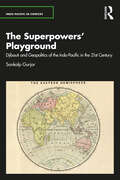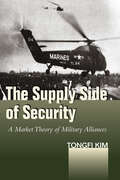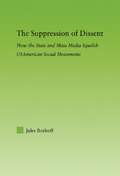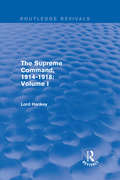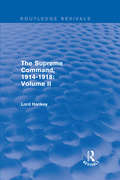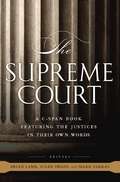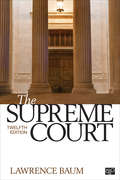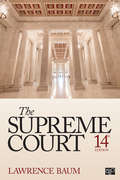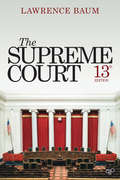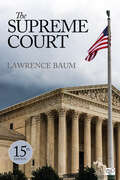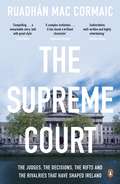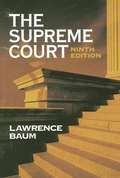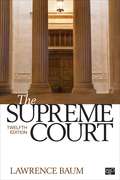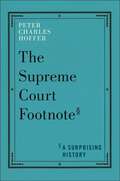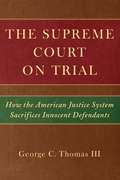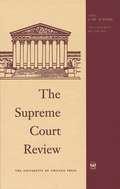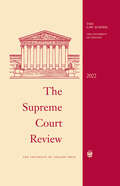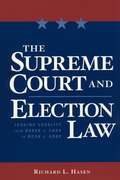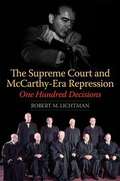- Table View
- List View
The Superpowers’ Playground: Djibouti and Geopolitics of the Indo-Pacific in the 21st Century (Indo-Pacific in Context)
by Sankalp GurjarThis book analyses the evolving geopolitics in the Indo-Pacific region and explains how Djibouti fits in the global strategies of four major powers—the US, China, Japan, and France. It shows how Djibouti is emerging as a key nation in the geopolitics of the Indo-Pacific, explores the interconnections between Djibouti and the Indian as well as Pacific Oceans, and through Djibouti examines broader trends in contemporary great power politics in the Indo-Pacific region, including the Belt and Road Initiative of China. Moving beyond contemporary works on the region, the author integrates Africa and the Middle East with discussions on the Indo-Pacific to illustrate the coalescing of strategic geography from Eastern Africa to the Western coast of the Americas. A major intervention, the volume will be essential reading for scholars, practitioners, and researchers of politics and international relations, security studies, African studies, peace and conflict studies, and maritime studies.
The Supply Side of Security: A Market Theory of Military Alliances
by Tongfi KimThe Supply Side of Security conceptualizes military alliances as contracts for exchanging goods and services. At the international level, the market for these contracts is shaped by how many countries can supply security. Tongfi Kim identifies the supply of policy concessions and military commitments as the main factors that explain the bargaining power of a state in a potential or existing alliance. Additionally, three variables of a state's domestic politics significantly affect its negotiating power: whether there is strong domestic opposition to the alliance, whether the state's leader is pro-alliance, and whether that leader is vulnerable. Kim then looks beyond existing alliance literature, which focuses on threats, to produce a deductive theory based on analysis of how the global power structure and domestic politics affect alliances. As China becomes stronger and the U.S. military budget shrinks, The Supply Side of Security shows that these countries should be understood not just as competing threats, but as competing security suppliers.
The Suppression of Dissent: How the State and Mass Media Squelch USAmerican Social Movements (New Approaches in Sociology)
by Jules BoykoffDespite longstanding traditions of tolerance, inclusion, and democracy in the United States, dissident citizens and social movements have experienced significant and sustained - although often subtle and difficult-to observe - suppression in this country. Using mechanism-based social-movement theory, this book explores a wide range of twentieth century episodes of contention, involving such groups as mid-century communists, the Black Panther Party, the American Indian Movement, and the modern-day globalization movement.
The Supreme Command, 1914-1918: Volume I (Routledge Revivals)
by Lord HankeyLord Hankey (1877-1963) was a British civil servant and the first Cabinet Secretary, a top aide to Prime Minister David Lloyd George and the War Cabinet that directed Britain in World War One. Mostly derived from the author’s diaries, which begin in March 1915, this study describes how Lord Hankey contributed to the development of the British system of Cabinet Government during the war years. First published in 1961, the two-volume collection is a history of the Supreme Command of the War; the conduct of the war, the development of the Supreme Command from Balfour to Lloyd George, and the emergence of the Cabinet Secretariat from the Secretariat of the War Cabinet. It contains intimate glimpses of the statesmen, sailors and soldiers who guided affairs towards 1918. This is a fascinating first-hand examination of the people who influenced the conduct of the war, and will be of particular value to students interested in its diplomatic history.
The Supreme Command, 1914-1918: Volume II (Routledge Revivals)
by Lord HankeyLord Hankey (1877-1963) was a British civil servant and the first Cabinet Secretary, a top aide to Prime Minister David Lloyd George and the War Cabinet that directed Britain in World War One. Mostly derived from the author’s diaries, which began in March 1915, this study describes how Lord Hankey contributed to the development of the British system of Cabinet Government during the war years. First published in 1961, the two-volume collection is a history of the Supreme Command of the War; the conduct of the war, the development of the Supreme Command from Balfour to Lloyd George, and the emergence of the Cabinet Secretariat from the Secretariat of the War Cabinet. It contains intimate glimpses of the statesmen, sailors and soldiers who guided affairs towards 1918. This is a fascinating first-hand examination of the people who influenced the conduct of the war, and will be of particular value to students interested in its diplomatic history.
The Supreme Court
by Brian Lamb Susan SwainThis singular collection of original interviews with all nine sitting Supreme Court justices plus retired Justice Sandra Day O'Connor--as well as reporters, attorneys, and historians--gives readers a rare window into the nation's highest court and those who serve there.
The Supreme Court
by Brian Lamb Susan Swain C-Span Mark FarkasThe Supreme Court grew out of a unique opportunity to interview all nine sitting Supreme Court Justices plus retired Justice O'Connor for a documentary on the Supreme Court. Through Brian Lamb and Susan Swain's interviews with our country's most influential judges, the book offers portraits of the Justices that introduces readers to the closed world of the Supreme Court, and what's it's really like to serve on the nation's highest Court.Accompanying the Justices around the Supreme Court, and through offices steeped in historic memorabilia, Lamb and Swain offer readers a window into a fascinating world to which few have had access. In these pages, Justice Sotomayor reflects on her first impressions of the job and the acclimation process. Justice Breyer takes us behind the scenes on a private tour of his Chambers as he describes how the Court works. And Chief Justice Roberts talks about the role of the Court in Society, the role of the Chief Justice, and the process of deciding cases.Enriching this unique material are interviews with journalists, court historians, and other experts on the Court. Journalists Joan Biskupic and Lyle Denniston (the longest serving Supreme Court reporter) talk about the process that unfolds in the Court and the impact of a new member of the Court. Clerk of the Supreme Court William Suter provides insights into the traditions of the Court. Historian Jim O'Hara discusses the Supreme Court building and its history. Two attorneys who have argued numerous cases in front of the Supreme Court tell readers what it's like facing the justices in fast paced oral arguments.Vividly illustrated with color photographs, the book is a perfect gift for anyone interested in the makings of this powerful institution.
The Supreme Court
by Brian Lamb Susan SwainThe Supreme Court grew out of a unique opportunity to interview all nine sitting Supreme Court Justices plus retired Justice O'Connor for a documentary on the Supreme Court. Through Brian Lamb and Susan Swain's interviews with our country's most influential judges, the book offers portraits of the Justices that introduces readers to the closed world of the Supreme Court, and what's it's really like to serve on the nation's highest Court. Accompanying the Justices around the Supreme Court, and through offices steeped in historic memorabilia, Lamb and Swain offer readers a window into a fascinating world to which few have had access. In these pages, Justice Sotomayor reflects on her first impressions of the job and the acclimation process. Justice Breyer takes us behind the scenes on a private tour of his Chambers as he describes how the Court works. And Chief Justice Roberts talks about the role of the Court in Society, the role of the Chief Justice, and the process of deciding cases. Enriching this unique material are interviews with journalists, court historians, and other experts on the Court. Journalists Joan Biskupic and Lyle Denniston (the longest serving Supreme Court reporter) talk about the process that unfolds in the Court and the impact of a new member of the Court. Clerk of the Supreme Court William Suter provides insights into the traditions of the Court. Historian Jim O'Hara discusses the Supreme Court building and its history. Two attorneys who have argued numerous cases in front of the Supreme Court tell readers what it's like facing the justices in fast paced oral arguments. Vividly illustrated with color photographs, the book is a perfect gift for anyone interested in the makings of this powerful institution.
The Supreme Court
by Lawrence A. BaumThe Supreme Court, Twelfth Edition, examines all major aspects of the highest court in the nation, from the selection of justices and agenda creation to the decision-making process and the Court’s impact on government and U.S. society. Delving deeply into personalities and procedures, author Lawrence Baum provides a balanced explanation of the Court’s actions and the behavior of its justices as he reveals its complexity, reach, and influence. This new edition gives particular attention to current developments such as the impact of political polarization on the Court, the justices’ increasingly public roles, and recent rulings on same-sex marriage and health care.
The Supreme Court
by Lawrence A. BaumThe Supreme Court, Twelfth Edition, examines all major aspects of the highest court in the nation, from the selection of justices and agenda creation to the decision-making process and the Court’s impact on government and U.S. society. Delving deeply into personalities and procedures, author Lawrence Baum provides a balanced explanation of the Court’s actions and the behavior of its justices as he reveals its complexity, reach, and influence. This new edition gives particular attention to current developments such as the impact of political polarization on the Court, the justices’ increasingly public roles, and recent rulings on same-sex marriage and health care.
The Supreme Court
by Lawrence A. BaumIn The Supreme Court, Lawrence Baum provides a brief yet comprehensive introduction to the U.S. Supreme Court, one that is balanced and illuminating. In successive chapters, the book examines each major aspect of the Court: the selection, backgrounds, and departures of justices; the creation of the Court′s agenda; the decision-making process and the factors that shape the Court′s decisions; the substance of the Court′s policies; and the Court′s impact on government and American society. Describing the Court′s personalities and procedures, and delving deeply to explain the actions of the Court and the behavior of justices, Baum shows students the Court′s complexity and reach. Tables and figures, plus a lively photo program, make this one of the most engaging books available. It is simply the standard.
The Supreme Court
by Lawrence A. BaumConnecting recent events to their effects on the courts, policy, and society, the Thirteenth Edition of The Supreme Court provides a brief yet comprehensive introduction to the U.S. Supreme Court. In successive chapters, the book examines major aspects of the Court, including the selection, backgrounds, and departures of justices; the creation of the Court's agenda; the decision-making process and the factors that shape the Court's decisions; the substance of the Court's policies; and the Court's impact on government and American society. Delving deeply into personalities and procedures, author Lawrence Baum provides a balanced explanation of the Court’s actions and the behavior of its justices as he reveals its complexity, reach, and influence. Updated with the most recent data displayed in a lively photo program, the new edition of this bestseller is one of the most engaging books on this subject available.
The Supreme Court
by Lawrence A. BaumConnecting recent events to their effects on the courts, policy, and society, the Thirteenth Edition of The Supreme Court provides a brief yet comprehensive introduction to the U.S. Supreme Court. In successive chapters, the book examines major aspects of the Court, including the selection, backgrounds, and departures of justices; the creation of the Court's agenda; the decision-making process and the factors that shape the Court's decisions; the substance of the Court's policies; and the Court's impact on government and American society. Delving deeply into personalities and procedures, author Lawrence Baum provides a balanced explanation of the Court’s actions and the behavior of its justices as he reveals its complexity, reach, and influence. Updated with the most recent data displayed in a lively photo program, the new edition of this bestseller is one of the most engaging books on this subject available.
The Supreme Court
by Lawrence A. BaumIn The Supreme Court, Lawrence Baum provides a brief yet comprehensive introduction to the U.S. Supreme Court, one that is balanced and illuminating. In successive chapters, the book examines each major aspect of the Court: the selection, backgrounds, and departures of justices; the creation of the Court′s agenda; the decision-making process and the factors that shape the Court′s decisions; the substance of the Court′s policies; and the Court′s impact on government and American society. Describing the Court′s personalities and procedures, and delving deeply to explain the actions of the Court and the behavior of justices, Baum shows students the Court′s complexity and reach. Tables and figures, plus a lively photo program, make this one of the most engaging books available. It is simply the standard.
The Supreme Court
by Lawrence A. BaumIn The Supreme Court, Lawrence Baum provides a brief yet comprehensive introduction to the U.S. Supreme Court, one that is balanced and illuminating. In successive chapters, the book examines each major aspect of the Court: the selection, backgrounds, and departures of justices; the creation of the Court′s agenda; the decision-making process and the factors that shape the Court′s decisions; the substance of the Court′s policies; and the Court′s impact on government and American society. Describing the Court′s personalities and procedures, and delving deeply to explain the actions of the Court and the behavior of justices, Baum shows students the Court′s complexity and reach. Tables and figures, plus a lively photo program, make this one of the most engaging books available. It is simply the standard.
The Supreme Court
by Lawrence A. BaumIn The Supreme Court, Lawrence Baum provides a brief yet comprehensive introduction to the U.S. Supreme Court, one that is balanced and illuminating. In successive chapters, the book examines each major aspect of the Court: the selection, backgrounds, and departures of justices; the creation of the Court′s agenda; the decision-making process and the factors that shape the Court′s decisions; the substance of the Court′s policies; and the Court′s impact on government and American society. Describing the Court′s personalities and procedures, and delving deeply to explain the actions of the Court and the behavior of justices, Baum shows students the Court′s complexity and reach. Tables and figures, plus a lively photo program, make this one of the most engaging books available. It is simply the standard.
The Supreme Court
by Ruadhán Mac Cormaic'A wonderful book ... a superb book and it's not just for people interested in law; it tells you a lot about Ireland' Vincent Browne, TV3The judges, the decisions, the rifts and the rivalries - the gripping inside story of the institution that has shaped Ireland.'Combines painstaking research with acute analysis and intelligence' Colm Tóibín, Irish Times' Books of the Year'[Mac Cormaic] has done something unprecedented and done it with a striking maturity, balance and adroitness. He creates the intimacy necessary but never loses sight of the wider contexts; this is not just a book about legal history; it is also about social, political and cultural history ... [the Supreme Court] has found a brilliant chronicler in Ruadhan Mac Cormaic' Diarmaid Ferriter, Professor of Modern Irish History, UCD'Mac Cormaic quite brilliantly tells the story ... balanced, perceptive and fair ... a major contribution to public understanding' Donncha O'Connell, Professor of Law, NUIG, Dublin Review of Books'Compelling ... a remarkable story, told with great style' Irish Times'Authoritative, well-written and highly entertaining' Sunday TimesThe work of the Supreme Court is at the heart of the private and public life of the nation. Whether it's a father trying to overturn his child's adoption, a woman asserting her right to control her fertility, republicans fighting extradition, political activists demanding an equal hearing in the media, women looking to serve on juries, the state attempting to prevent a teenager ending her pregnancy, a couple challenging the tax laws, a gay man fighting his criminalization simply for being gay, a disabled young man and his mother seeking to vindicate his right to an education, the court's decisions can change lives.Now, having had unprecedented access to a vast number of sources, and conducted hundreds of interviews, including with key insiders, award-winning Irish Times journalist Ruadhan Mac Cormaic lifts the veil on the court's hidden world.The Supreme Court reveals new and surprising information about well-known cases. It exposes the sometimes fractious relationship between the court and the government. But above all it tells a story about people - those who brought the cases, those who argued in court, those who dealt with the fallout and, above all, those who took the decisions. Judges' backgrounds and relationships, their politics and temperaments, as well as the internal tensions between them, are vital to understanding how the court works and are explored here in fascinating detail.The Supreme Court is both a riveting read and an important and revealing account of one of the most powerful institutions of our state.Ruadhan Mac Cormaic is the former Legal Affairs Correspondent and Paris Correspondent of the Irish Times. He is now the paper's Foreign Affairs Correspondent.
The Supreme Court (9th edition)
by Lawrence BaumBaum (political science, Ohio State U.) presents a short guide for readers who know a lot or a little about the highest court in the US. No dates are noted for earlier editions; this one reflects new scholarship and developments such as the Bush v. Gore case and its repercussions. Cited in Books for College Libraries, 3d. ed. Annotation ©2004 Book News, Inc., Portland, OR (booknews.com)
The Supreme Court 12th edition
by Lawrence BaumThe book examines each major aspect of the Court: the selection, backgrounds, and departures of justices; the creation of the Court's agenda; the decision-making process and the Court's impact on government and American society.
The Supreme Court Footnote: A Surprising History
by Peter Charles HofferA history of the humble footnote and its impact on the highest court in the landIn May 2022, a seismic legal event occurred as the draft majority opinion in Dobbs v. Jackson Women’s Health was leaked. The majority aimed to eliminate constitutional protection for abortion. Amidst the fervor, an unnoticed detail emerged: over 140 footnotes accompanied the majority opinion and dissent. These unassuming annotations held immense significance, unveiling justices’ beliefs about the Constitution’s essence, highlighting their controversial reasoning, and laying bare the vastly different interpretations of the role of Supreme Court Justice.The Supreme Court Footnote offers a study of the evolution of footnotes in US Supreme Court opinions and how they add to our constitutional understanding. Through a comprehensive analysis, Peter Charles Hoffer argues that as justices alter the course of history via their decisions, they import their own understandings of it through the footnotes. The book showcases how the role of the footnote within Supreme Court opinions has evolved, beginning with one of the first cases in the history of the court, Chisholm v. Georgia in 1792 (a case concerning federalism vs. states’ rights) and ending with the landmark Dobbs v. Jackson case in 2022. Along the way, Hoffer demonstrates how the footnotes within these decisions reflect the changing role of the Supreme Court Justice, along with how interpretations of the constitution have transformed over time.At once surprising and revealing, The Supreme Court Footnote proves that what appears below the line is not only a unique window into the history of constitutional law but also a source of insight as to how the court will act going forward.
The Supreme Court On Trial: How the American Justice System Sacrifices Innocent Defendants
by George C. Thomas IIIThe chief mandate of the criminal justice system is not to prosecute the guilty but to safeguard the innocent from wrongful convictions; with this startling assertion, legal scholar George Thomas launches his critique of the U. S. system and its emphasis on procedure at the expense of true justice. Thomas traces the history of jury trials, an important component of the U. S. justice system, since the American Founding. In the mid-twentieth century, when it became evident that racism and other forms of discrimination were corrupting the system, the Warren Court established procedure as the most important element of criminal justice. As a result, police, prosecutors, and judges have become more concerned about following rules than about ensuring that the defendant is indeed guilty as charged. Recent cases of prisoners convicted of crimes they didn't commit demonstrate that such procedural justice cannot substitute for substantive justice. American justices, Thomas concludes, should take a lesson from the French, who have instituted, among other measures, the creation of an independent court to review claims of innocence based on new evidence. Similar reforms in the United States would better enable the criminal justice system to fulfill its moral and legal obligation to prevent wrongful convictions. George C. Thomas III is Professor of Law and Judge Alexander P. Waugh, Sr. , Distinguished Scholar at Rutgers School of Law. "Thomas draws on his extensive knowledge of the field to elaborate his elegant and important thesis---that the American system of justice has lost sight of what ought to be its central purpose---protection of the innocent. " ---Susan Bandes, Distinguished Research Professor of Law, DePaul University College of Law "Thomas explores how America's adversary system evolved into one obsessed with procedure for its own sake or in the cause of restraining government power, giving short shrift to getting only the right guy. His stunning, thought-provoking, and unexpected recommendations should be of interest to every citizen who cares about justice. " ---Andrew E. Taslitz, Professor of Law, Howard University School of Law "An unflinching, insightful, and powerful critique of American criminal justice---and its deficiencies. George Thomas demonstrates once again why he is one of the nation's leading criminal procedure scholars. His knowledge of criminal law history and comparative criminal law is most impressive. " ---Yale Kamisar, Distinguished Professor of Law, University of San Diego and Clarence Darrow Distinguished University Professor Emeritus of Law, University of Michigan
The Supreme Court Review 2011
by The University of Chicago PressFor fifty years, The Supreme Court Review has been lauded for providing authoritative discussion of the Court's most significant decisions. The Review is an in-depth annual critique of the Supreme Court and its work, keeping up on the forefront of the origins, reforms, and interpretations of American law. Recent volumes have considered such issues as post-9/11 security, the 2000 presidential election, cross burning, federalism and state sovereignty, failed Supreme Court nominations, and numerous First and Fourth amendment cases.
The Supreme Court Review, 2022 (Supreme Court Review)
by The University of Chicago PressAn annual peer-reviewed law journal covering the legal implications of decisions by the Supreme Court of the United States. Since it first appeared in 1960, the Supreme Court Review has won acclaim for providing a sustained and authoritative survey of the implications of the Court's most significant decisions. SCR is an in-depth annual critique of the Supreme Court and its work, analyzing the origins, reforms, and modern interpretations of American law. SCR is written by and for legal academics, judges, political scientists, journalists, historians, economists, policy planners, and sociologists.
The Supreme Court and Election Law: Judging Equality from Baker v. Carr to Bush v. Gore
by Richard Hasen&“A pioneering study of the Court&’s increasing efforts to regulate the US political system&” from the author of A Real Right to Vote (Bruce Cain, University of California, Berkeley). In the first comprehensive study of election law since the Supreme Court decided Bush v. Gore, Richard L. Hasen rethinks the Court&’s role in regulating elections. Drawing on the case files of the Warren, Burger, and Rehnquist courts, Hasen roots the Court&’s intervention in political process cases to the landmark 1962 case, Baker v. Carr. The case opened the courts to a variety of election law disputes, to the point that the courts now control and direct major aspects of the American electoral process. The Supreme Court does have a crucial role to play in protecting a socially constructed &“core&” of political equality principles, contends Hasen, but it should leave contested questions of political equality to the political process itself. Under this standard, many of the Court&’s most important election law cases from Baker to Bush have been wrongly decided. &“A must-read for anyone interested in the intersection of law and politics . . . [Hasen&’s] is an important framework against which election law scholars will react and upon which they will build for some time to come.&” —Michigan Law Review &“Hasen engagingly draws on internal Court deliberations, as well as political science and legal theory, to assess and criticize dramatic transformations in the role of constitutional law in overseeing the structure of democracy.&” —Richard H. Pildes, NYU School of Law &“A major contribution to the field of election law.&” —Thomas E. Mann, The Brookings Institution
The Supreme Court and McCarthy-Era Repression: One Hundred Decisions
by Robert M. LichtmanThe 1950s "Red Scare" marks one of the stormiest periods in U.S. Supreme Court history. Robert M. Lichtman provides the definitive history of the high court's decisions in every one of the "Communist" cases it decided, placing each within the context of the time and revealing the broad range and impact of McCarthy-era repression. Making extensive use of the justices' papers, Lichtman examines the dynamics of the Court's changes in direction, from the Vinson Court's rubber-stamping of government action against subversives to the Warren Court's more liberal rulings and the subsequent retreat led by Felix Frankfurter. Lichtman's account details the Court's surprising vulnerability to popular and political attack and reveals the behind-the-scenes relationships and rivalries among justices. At the same time, he recounts in devastating detail the injuries inflicted by McCarthyism on individuals and the nation.
